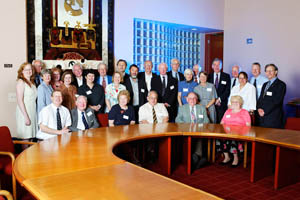


A chapter in the evolution of paediatrics in Australia
Introduction
Participants
Origins of the Department
Early developments
Leadership
New directions in patient care, research and teaching
Ethical issues in research and treatment
Formalising the research effort
Training Programs
Surgical research and training
Finding funds for research
Establishing sub-specialty departments
More on medical education
Academic outreach
Endnotes
Index
Search
Help
Contact us

Kester Brown: Vernon told me about how when he was a young fellow during the war, he gave anaesthetics for tonsils in England. The patients went home on the same day. I think this experience was probably something that encouraged him to introduce a half-time, then a full-time Director of Anaesthesia in the search for better care.
Roger Hall: Someone mentioned before about translating a clinic to a department. It was Vernon who guided me in 1967. I felt by that stage we were large enough and encompassed a number of different dental specialties. It was appropriate that we should be a Department [of Dentistry]. And Vernon was the person - rather than others in the hospital's administration - who guided me as to how this should be brought about. He went about it with a couple of discussions. I felt he still retained that bit of an interest in my progress as a clinician.
Henry Ekert: I think it's important that I mention that whilst we are talking about influential figures in the department, a third figure who didnít have his foot in either camp was John Colebatch.[68] I worked with John on his research. I think he was on the outer and had a very tough time combining his clinical work with research into the treatment of childhood leukaemia. If not for his obsessive drive, I donít believe that the prospects for children, which were regarded as hopeless, would have improved as far or fast as they did.
Arthur Clark: Can I come in to support these opinions and to say that Vernon sort of delegated me to work with John Colebatch in 1960. John was isolated in many ways, but Vernon was one of the few people who supported him.
Ann Westmore: So he was doing major work with chemotherapy in young patients who otherwise were expected to die of leukaemia within a few weeks? Can you recall, Arthur, what Vernon's support for John Colebatch amounted to?
Arthur Clark: It amounted to recognition that this was an appropriate thing to be doing. It wasn't financial support or support in the sense of getting a department established. There were lots of other people in the hospital who wished John would go away, including Howard who was very critical of Johnís approach. Vernon said, this is something that needs to be done and he supported him.
David McCredie: We were also criticised in some quarters for prolonging the life of children with kidney disease by using unpleasant procedures [for example, kidney transplantation[69] and renal dialysis].[70] There was John [Colebatch] getting a respectable number of patients with some increases in length of life, but still they were sick and miserable. Perhaps it's inevitable that whenever a treatment is pioneered for a condition that is universally fatal, you are bound to get some criticism.

Participants at the Witness seminar available at the lunch-time break.
Standing from left, Ms Kate Bride, Mr Don Kinsey, Professor Joan McMeeken , Dr Marjorie Dunlop, Dr Anne Rickards, Professor Henry Ekert, Professor Janet McCalman, Dr Jim Keipert, Dr Ann Westmore, Professor Frank Oberklaid, Dr John Rogers, Dr Bernard Neal, Dr John McNamara, Professor Arthur Clark, Dr Pat Phair, Mr Durham Smith, Dr June McMullin (Danks), Professor Peter Phelan, Dr Max Robinson, Mrs Jenny Saravanamuttu, Dr Garry Warne, Associate Professor Roger Hall. Seated from left, Professor Glenn Bowes, Dr Winston Rickards, Dr Ruth Bishop, Dr Kester Brown, Dr Max Kent, Ms Barbara Clarke.
PHOTO: © Peter Casamento
 |
Witness to the History of Australian Medicine |  |
© The University of Melbourne 2005-16
Published by eScholarship Research Centre, using the Web Academic Resource Publisher
http://witness.esrc.unimelb.edu.au/015.html